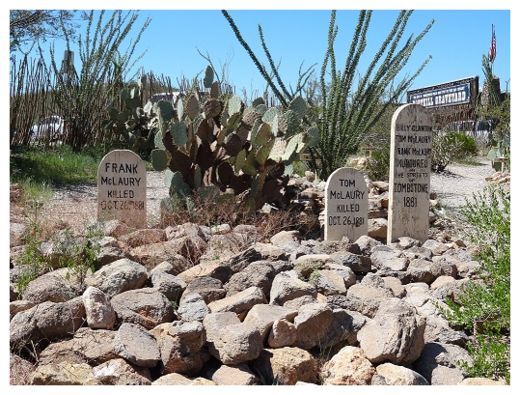
© Kieran Mulvaney
The purported grave site of the men who were killed in the Gunfight at the OK Corral.
The purported grave site of the men who were killed in the Gunfight at the OK Corral.
Minutes later, three men would be dead, and the four men who had walked to the corral and killed them - Tombstone marshal Virgil Earp, his brothers Wyatt and Morgan, and Wyatt's friend Doc Holliday - had unknowingly secured their places in history.
The Gunfight at the OK Corral is arguably the single most famous incident in the Old West. But what was it about? And why has it, above all the many other gunfights that took place in the era of frontier justice, achieved such infamy?
To understand the gunfight, you have to first understand the town. Tombstone in 1881 was a thriving, bustling silver mining community.
"There's a huge misconception about Tombstone in the 1880s: that it was a violent, dangerous place," says local author and historian Don Taylor. "It was extremely sophisticated and massively wealthy. Thirty-seven million dollars in 1880s dollars of silver was mined here; that's $8.25 billion today. They had everything.
"They had fresh seafood every day. They would catch it in Baja California; pack it in barrels of salt, ice and seaweed at dusk; freight it by train to Benson or Contention City, immediately pack it on to wagons and bring it here by dawn every day. It was a very opulent town. But again, people don't understand - especially if they come today - Tombstone was open 24 hours a day.
The miners worked rotating 10 hour shifts; everything had to be open when they got off, including banks. They were also pumping 2.5 million gallons of water out of the mines every day to keep them dry; so you had all the mining activity, all the milling activity, all the water rushing down Toughnut Street, and the town open 24 hours a day. It must have been noisy as hell."
As the mines thrived, so did all manner of supporting businesses: banks, bars, restaurants, hotels - and prostitutes, many of whom worked out of small 'cribs' that lined Sixth Street. The riches to be, had attracted plenty of would-be entrepreneurs -- among them Wyatt, Virgil, Morgan, James and Warren Earp, and Doc Holliday.
Both Virgil and Wyatt had been lawmen; Virgil had recently been appointed deputy marshal for the part of the Arizona Territory that included Tombstone, and although some record-keeping at the time was poor, it is possible that Wyatt may have been a deputy marshal as well.
Certainly, it appears as if all the brothers were anxious to join the list of those profiting from Tombstone's booming business: they invested in one of the mines, James tended bar, Wyatt rode as a stagecoach guard and dealt faro - the popular card game of the time - in a local saloon.
But Tombstone's growth and growing sophistication grated with one segment of society: the 'cowboys', a loose confederation of ranchers and cattle rustlers. The cowboys - who were predominantly rural, southern Confederates - eyed the primarily Yankee mercantile class that was dominating Tombstone, and which the Earps typified, with suspicion. And the feeling was mutual.
It didn't take long after the Earps' arrival in late 1879 for tensions between them and the cowboys to develop, particularly with Virgil and Wyatt spending time in law enforcement positions. That tension reached boiling point when Wyatt helped in the identification and arrest of some cowboy members in a pair of stagecoach robberies, and the cowboys in turn asserted that Wyatt and Holliday had in fact been the ones responsible for the holdups.
On the night of Oct. 25, 1881, one of the cowboy leaders, Ike Clanton, got into a heated, drunken argument with Holliday, and the next morning he wandered drunkenly up and down Allen Street, threatening to kill him and the Earps. A series of confrontations steadily escalated until Virgil was informed that a group of armed cowboys had gathered outside Fly's Boarding House - where Holliday was living - in a vacant lot close to the OK Corral.
Carrying guns inside city limits was a violation of a town ordinance, and it provided Virgil, who was now town marshal, with an opportunity to arrest the cowboys. But there may also have been other considerations at play.
As the self-identified Dr. Jay, who leads historical tours of Tombstone, explains: "Ike Clanton had openly threatened to kill the Earps. And why are they in that alley? Because it's right outside Fly's Boarding House. So if you're Doc Holliday, you show up and here's a bunch of guys with guns outside your house. You might want to think about, 'Are they going to get me tomorrow if I don't get them today?
Read more at - http://www.sott.net/article/252812-What-happened-at-the-OK-Corral